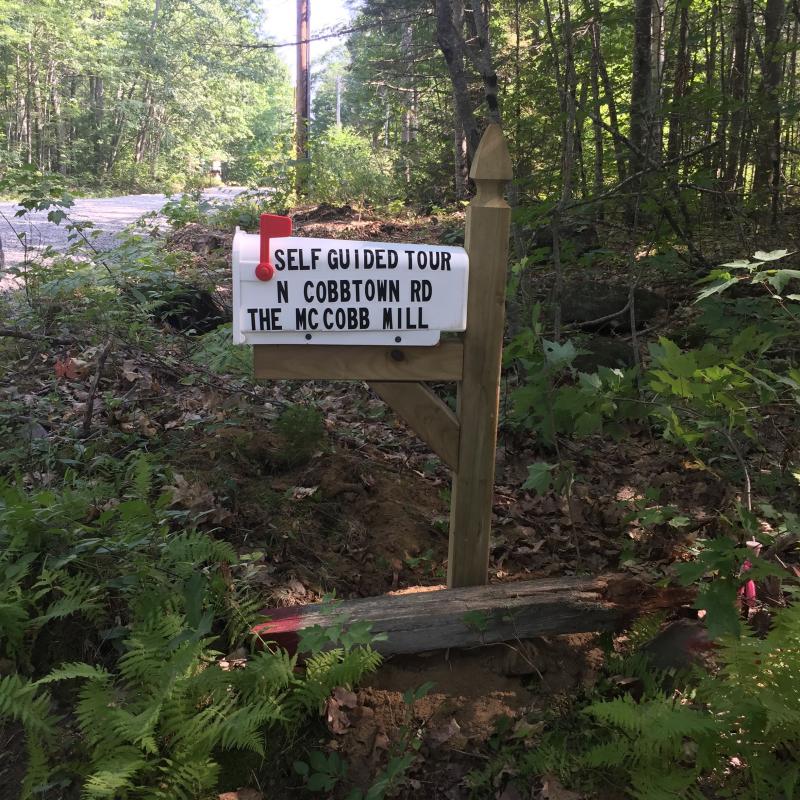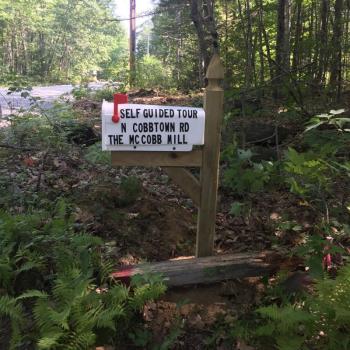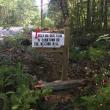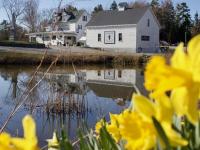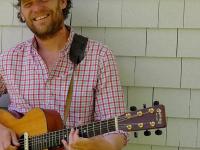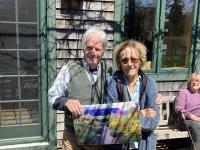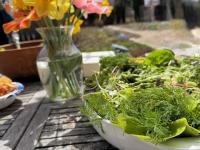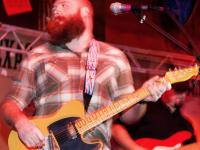This Week in Lincolnville: Field Trip Season Starts
Remember the excitement of a field trip? The permission slips Mom had to sign, the bag lunch you brought from home, the big yellow bus idling out front of the school, wondering who you’d get to sit next to … most of all, though we wouldn’t have put it this way, a field trip meant a change of scene, a day away.
Boy, don’t we all need that about now?
One evening last week I texted my D-I-L (yes, we text back and forth, upstairs to down, back to upstairs with every mundane thing: “did you let the hens out?”, “I’ll make us lunch”, “send your grocery list”) to tell the kids we were going on a field trip the next day. Where they wondered. “It’s a surprise,” I replied.
So after lunch, after their morning lessons were over, we piled into the van and drove to a place I knew they’d never been. “Wear boots and long pants (the eight- year-old has been wearing shorts and a T-shirt for the past couple of months, no jacket if he can get away with it), bring bug spray, paper and pen.” Oh, and a snack.
Their mom came too, as ready as they were for the promised change of scene. A mere three miles from home, still in Lincolnville, we parked and walked into the woods. It’s a friend’s land and has everything: forest, trails, history – the remnants of the past couple of centuries – and water galore. We saw beaver-chewed trees, uncovered a spotted salamander, watched a critter, probably a beaver, swimming, gaped at a crumbling down camp, c. 1950, and climbed over the rocks walls of another age.
Since this was a genuine field trip, they took notes, made drawings, asked questions. They sniffed skunk cabbage, carefully covered up the salamander, and came home with only a few ticks. And I had a chance to tell them about what they were seeing, how the piles of huge rocks were lime kilns, and what they had been used for, talked about where the roads used to go.
The day got me thinking of other field trips we can take. The next time we’ll start at the Jackie Young Watts Open Air Museum next to the Library with its large map of the town. Old houses, 100 years or more, are shown with their current street address; other features such as cemeteries, cellar holes, lime kilns, one-room schools, etc. can be located using the key. “Find where we live,” I’ll tell them, and then see what else is in our neighborhood.
The two open-fronted sheds – Life on the Bay and The Rural Economy – show how our ancestors in this town survived. And whether or not your own people lived here, this is how all our ancestors made their living wherever we’re from. Even city dwellers come from the land somewhere back in their history.
Maybe we’ll go to a cemetery. Lincolnville has 23 cemeteries which includes a few private family plots, a couple of single graves, and some six “active” cemeteries. The Lincolnville Historical Society website lists them all with a story about each one, photographs, a list of graves, and a map to find them.
How about taking your kids on a field trip to one? Look at the gravestones, the dates, the ages of the people when they died. A project might be to choose one name and then, back home, research that person or family. I spent a fascinating hour the other day on Ancestry.com, the free Library edition we can use at home. It’s a fun way to teach kids how to do research using the primary source of a grave. Here are the ones that are accessible to the public; some are on private land and can be seen only with permission.
Youngtown Cemetery, entrance on Camden Road/Rt. 52, two stone pillars nearly across from Fernalds Neck Road
Maplewood Cemetery, on Ducktrap Road near Atlantic Highway/Rt. 1
French Cemetery, on Atlantic Highway, entrance right next to Dot’s; looks like a private driveway but is the way into the cemetery
Union Cemetery, on Belfast Road/Rt. 52 near Slab City and Greenacre Road intersection
Center Lincolnville Burying Ground, Heal Road near Center
Hillside Cemetery, also on Heal Road
Norton or Old Settlers Cemetery, on Belfast Road near where Joy Road comes in
Hills Cemetery, on Vancycle Road, which is nearly to the Northport line on Belfast Road
Cross and Fletcher Cemeteries, both right on High Street
Elenora French, the little girl who fell off the later-named Maiden Cliff, is buried in the French Cemetery. Find her grave. Who were her parents? Where did they live?
Fletcher Cemetery has the graves of several Revolutionary War soldiers. Can you identified which ones they were?
Center Lincolnville Burying Ground holds many of our town’s early families. Note how many of their descendants still live in town.
Norton Cemetery leaves me speechless; the hollows that are sunken graves; the plain field stones that mark them, head and foot; a great “prompt” for a story or a poem.
Once the weather warms up, take your homeschoolers down to Ducktrap at low tide. Hike up the stream, under the bridge and you’ll come upon the remnants of the 19th century dam. Be sure to wear “water” shoes, as Ducktrap is all rocks and stones.
Visit the Stetson Mill dam and millsite by hiking in off Slab City Road on the old Whitney Road across from and not far from North Chester Dean Road and the yellow house. It’s liable to be a buggy hike, so come prepared with bug spray and pant legs tucked into socks. You’ll come to a bridge and the site of a gristmill along Black Brook. Take the trail on the left soon after the bridge. It takes some exploring to find, but along that trail, which parallels Black Brook, there is a most amazing dam and rockwork, the Stetson Mill. I used to take my Cub Scout den down there, but haven’t been able to find it lately, it’s so overgrown. Let me know if you do.
There’s a cattle pound, a stone enclosure for wayward stock, up where Townhouse Road and Joy Road join. Also, somewhere up there the Harvell Cemetery.
The berm of the horse-drawn lime railroad encircles much of Coleman Pond, though you’d have to ask one of the pond dwellers to show it to you. Coleman has no public access. A walk along Slab City Road, not far from the old Whitney Road mentioned above, the Coleman Pond outlet that turns into Black Brook, is a good way to see the remnants of a sawmill and dam, as well as several crumbling lime kilns. They look like strange hummocks, with cedar growing around them, but they were kilns.
Another good exploratory hike is the Coastal Mountains Land Trust trail you access from Belfast Road/Rt. 52 not far from the Albert Blood Road; that’s the Ducktrap River you cross. Heading to Belfast, take the left side trail. Again, the trail here parallels the river, which isn’t visible from where you’re walking. Bushwack down to it at different points; it’s a rich historical area with large bridge abutments, a mill site, and dam.
Drive down North Cobbtown Road and find what was once a thriving settlement. Corelyn Senn, who has done extensive research on the road, has erected two white mailboxes with leaflets to take, one between 4th and 5th Avenues and the other between 9th and 10th Avenues. The first describes the McCobb Mill and has a tour of the road and the other describes the Field and Delano Cemeteries which can be seen nearby.
These are only a few of the many, many good hikes and easy walks and things to see right outside our own doors. I focus on the history, but even a simple walk along any road is a chance to identify the plants springing up through the gravel shoulder and in the ditches. I have this app – inaturalist on my phone. Snap a photo of a plant or an aninal track or a bug or a shell and it tells you what it likely is.
There you have it, homeschooling parents. Social Studies and Science covered right in our own backyard, with perhaps a sprinkling of LA (that’s Language Arts or English as we used to call it).
Just be sure to have plenty of bug spray, head nets even, in case those little blackfly buggers are swarming, and boots because it’s wet everywhere this time of year, and oh, a snack.
If by chance your little student, or perhaps you, wants to know more about what they find around town, here are four books that can help:
Ducktrap: Chronicles of a Maine Village and Staying Put in Lincolnville: 1900-1950, both by me and available at Sleepy Hollow Rag Rugs
Notes on a Lost Flute, by Kerry Hardy
A Natural History of Camden and Rockport, by E.C. (Beedy) Parker
Town
The Recreation Committee did a 9 a.m. site walk at 2814 Atlantic Highway this morning. My family visited the town’s potential new shorefront property yesterday, located north of Ducktrap and currently owned by Coastal Mountains. A proposal to trade some town-owned frontage on the Ducktrap River for ownership of this large piece on the shore will come before voters at the annual Town Meeting, scheduled for July at this point. There’s lots of parking, two large fields and a real rest room (not portapotties!).
Town committees meet on Zoom these days. To participate in a meeting, or just to watch and listen to one, go to https://www.zoom.us/ then click on “Join a Meeting”; the ID for that meeting
The Selectmen meet Monday the 11th at 6 p.m. This remote meeting will be live streamed (and archived) via the Town’s site Or you can watch via Zoom; the ID is 859 1057 6150.
The Budget Committee holds a public hearing via Zoom Tuesday the 12th at 6 p.m. I don’t have an ID for that meeting.
The Broadband Committee meets at 7 p.m. this Thursday, May 14 via a Zoom meeting. Click on this link to join. The ID of the meeting is 876 9564 7375.
Another House Fire
Sadly, Lincolnville experienced another devastating house fire Sunday morning, the third this year, this one a trailer on Greenacre Road. The family living there weren’t home at the time, but unfortunately lost everything they had. Natasha Norwood posted this on a GoFundMe |
page: “We are family of 4 and have lost everything in a house fire that happened this morning. We have nothing but the clothes on our back. We are safe and have a roof over her head but we are asking for any help to get clothes and stuff that we lost in the fire. Re-opening Recycling Starting May 20 we can begin recycling certain materials at the dump and only on Wednesdays and Thursdays. Acceptable materials include cans, newsprint, #2 Natural plastic (milk bottles, etc.), #2 Colored/white plastic like detergent bottles, as well as corrugated cardboard and brown paper bags. How Can We Help? Here we are, going into our third month of being shut in, distanced from each other, with our local businesses and schools closed. Could be the opening paragraph of a science fiction novel, only this one’s not a novel. I find myself diligently reading Facebook several times a day, though I’m more a lurker than a participant; here’s what I’ve learn: Some of us are confined with our loved ones, our family. Some find themselves completely alone, maybe with pets, maybe not. Dogs and cats take on the personas of family members. I know a woman who has a tortoise for a companion, another who snuggles up with her hedgehog. Some of us find our human loved ones harder to be confined with than that hedgehog. Spouses, even those with no children in the house, are at times driven to distraction. Again, FB has hilarious memes to back that up. But almost universally, in our tiny world that is, people invariably say how lucky we are to have access to the outdoors, to our yards, gardens, the woods, the shore. So lucky we feel guilty knowing how much suffering is going on everywhere. No jobs, no paychecks, the actual COVID illness and death. Some, who have received the government’s $1200 check want to pass it on to a family that needs it more. Maine’s Good Shepherd Food Bank is one worthy recipient; so is a local church or the local businesses and services you regularly engage – hair or nail salon, barber, massage therapist, restaurant, house cleaner, etc. As we tell each other, we’ll get through this.
|
Event Date
Address
United States

